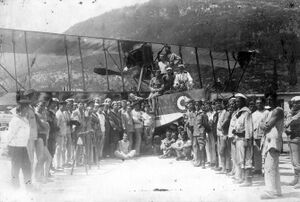Engineering:Macchi M.3
| Macchi M.3 | |
|---|---|

| |
| Role | Biplane flying boat |
| Manufacturer | Macchi |
| First flight | 1916 |
| Retired | 1924 |
| Primary user | Regia Marina |
| Number built | 200 |
| Developed from | Macchi L.2 |
The Macchi L.3, or later Macchi M.3, was an Italian biplane flying boat developed from the earlier L.2.
Development
The Macchi company had learned about flying boat design from copying an Austrian flying boat to produce the Macchi L.1 and improving it to produce the L.2. The result was the L.3, which was renamed the M.3 in 1917 to recognise the change in design from Lohner influenced to a Macchi design. Only the unequal-span biplane wings were inherited from the L.2; a new and refined hull and strut-mounted tailplane were designed. Like its predecessors, the new plane was powered by a single Isotta Fraschini engine strut mounted between the two wings and driving a pusher propeller. It was armed with a single machine gun on a trainable mounting and could also carry four light bombs. In 1916, one aircraft gained the world altitude record for a seaplane when it climbed to 5,400 m (17,700 ft) in 41 minutes.
Operational history
Over 200 M.3s were built and delivered to the Royal Italian Navy and were used on a variety of missions which including bombing, reconnaissance, patrol and escort. For a short period in 1917, it was also used as a fighter. Several aircraft were used in commando-style operations behind Austrian lines. The aircraft were highly regarded by the Royal Italian Navy and they were used on bombing raids and pioneered the Italian use of aerial photography. After World War I, the type was used by training units until 1924.
In 1919, an L.3 which belonged to the Italian Military Mission in Argentina connected Buenos Aires with Asunción, Paraguay for the first time. This plane was later donated to the Paraguayan government. Lieutenant Arturo Escario, who was already a pilot, trained in the L.3 in Argentina. This plane was destroyed in an accident on 30 September 1919. Its pilot, Lieutenant Escario, died the following day.
A number of second-hand aircraft were used by the Swiss company Ad Astra Aero to carry out charters and joy rides on the Swiss lakes, the two passengers were seated side-by-side behind a large windscreen with the pilot in a raised open cockpit further aft.[citation needed]
Two M.3s were fitted with Fiat A.12 engines and were re-designated Macchi M.4, but they were abandoned after completion in favour of the Macchi M.9.
Operators
 Kingdom of Italy
Kingdom of Italy
- Regia Marina
 Switzerland
Switzerland
- Ad Astra Aero
 Paraguay
Paraguay
Specifications
Data from The Illustrated Encyclopedia of Aircraft (Part Work 1982-1985). Orbis Publishing. pp. 2392.
General characteristics
- Crew: 2
- Wingspan: 15.95 m (52 ft 4 in)
- Gross weight: 1,350 kg (2,976 lb)
- Powerplant: 1 × Isotta Fraschini V.4B , 119 kW (160 hp)
Performance
- Maximum speed: 144 km/h (90 mph, 78 kn)
- Range: 385 km (239 mi, 208 nmi)
Armament
- 1 × Fiat machine-gun or a light cannon
- 4 × light bombs
See also
Related development
Aircraft of comparable role, configuration and era
Related lists
- List of seaplanes and flying boats
References
- Taylor, Michael J. H. (1989). Jane's Encyclopedia of Aviation. London: Studio Editions.
- The Illustrated Encyclopedia of Aircraft (Part Work 1982-1985). Orbis Publishing. pp. 2392.
- Sapienza Fracchia, Antonio Luis: "La Contribución Italiana en la Aviación Paraguaya". Author's edition. Asunción, 2007. 300pp.
 |


